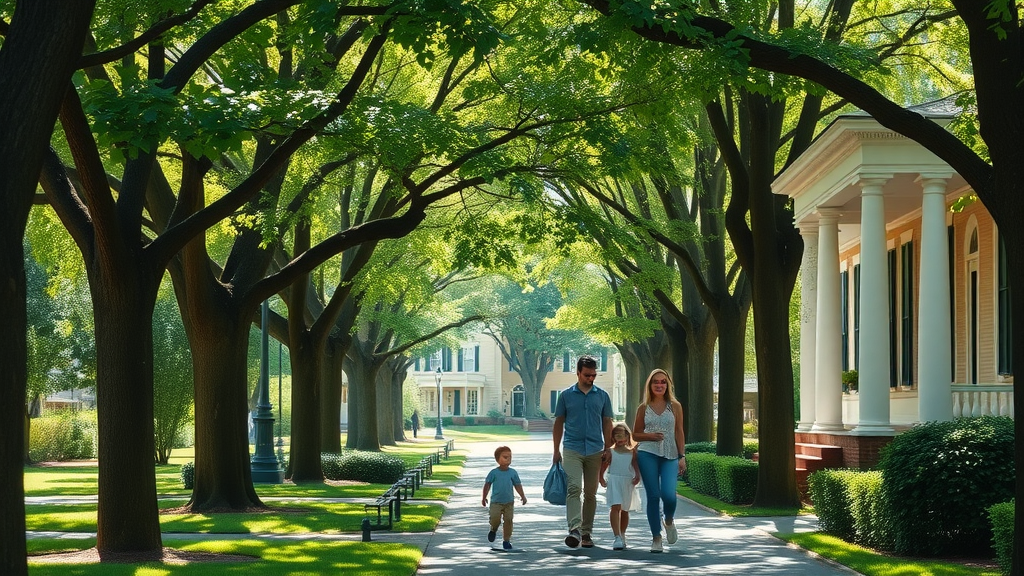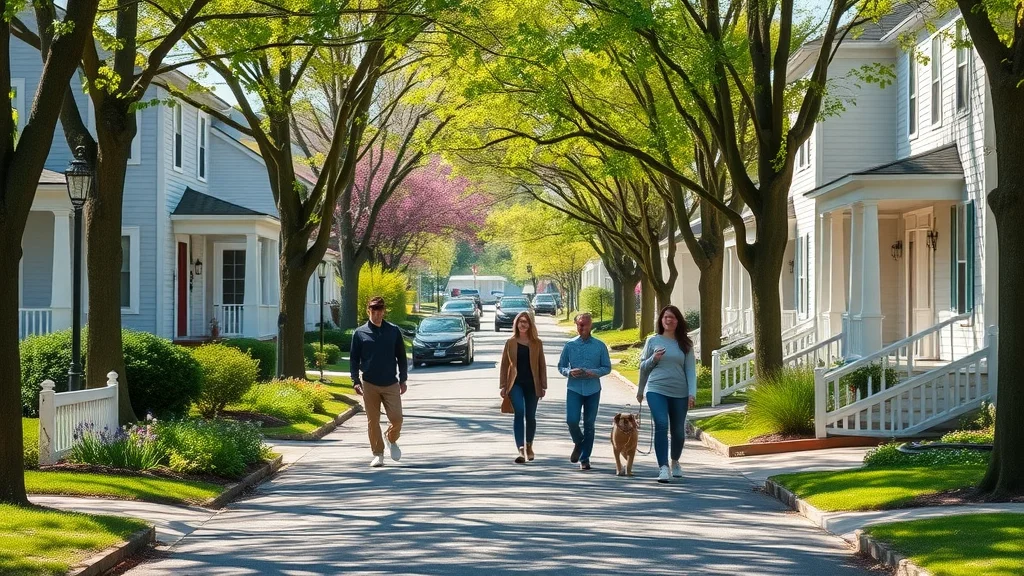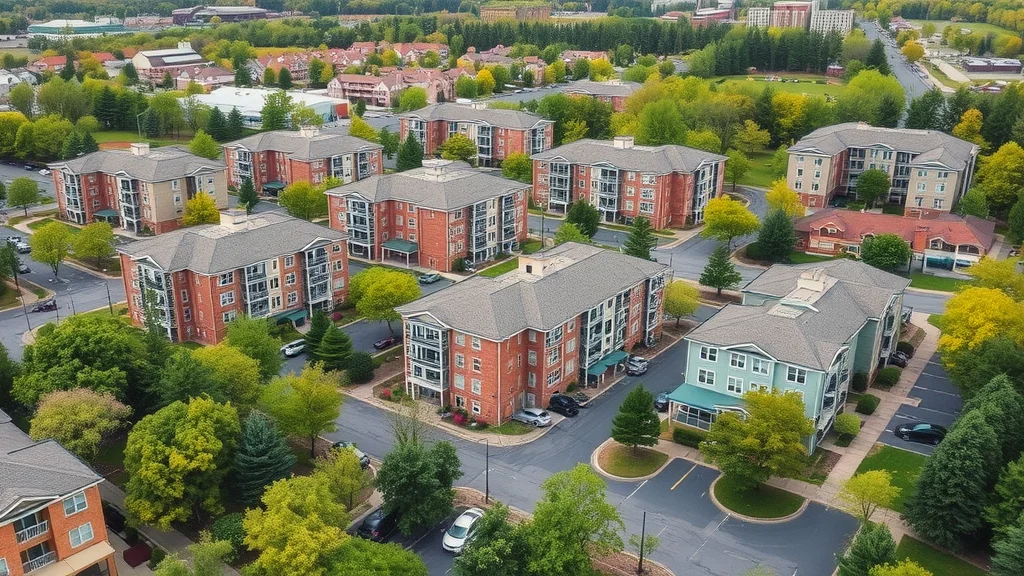"The average commute in Charlotte is nearly 26 minutes—higher than the national average. But the right neighborhood choice can shave valuable time off your day."
Are you tired of spending an extra half-hour—or more—stuck in Charlotte traffic each day? If so, you’re not alone. Commuting in Charlotte neighborhoods is a challenge many face, thanks to sprawling suburbs and the city’s rapid growth. But there’s good news: by making savvy neighborhood choices and leveraging modern public transit and traffic hacks, you can transform your daily drive into a more pleasant, efficient experience. In this guide, we break down 15 actionable strategies to simplify your commute, save time, and boost your quality of life in the Queen City.
Discover the Secrets to Stress-Free Commuting in Charlotte Neighborhoods
When it comes to commuting in Charlotte neighborhoods , the difference in your daily drive can be dramatic, depending on your location and transit choices. Some neighborhoods in Charlotte offer direct access to light rail, dedicated bus lanes, or even the ability to walk or bike to work. Others may add more than 15 minutes to each leg of your commute due to distance and lack of transit options. Knowing which neighborhoods offer the most efficient commutes and understanding available public transit options is crucial for anyone looking to optimize time, manage the cost of living , and improve work-life balance.
Let's explore practical, real-world examples of Charlotte residents who have cut their commute by half, review key statistics on commute times and real estate, and arm you with tips for getting around more efficiently. Whether you’re dreaming of Uptown's urban rush or the leafy streets of Myers Park, this guide empowers you to find the perfect balance between location, budget, and lifestyle.
- The top Charlotte neighborhoods that minimize your commute
- How public transit and transit options transform your daily journeys
- Key stats on commute times and real estate impact
- Actionable tips for navigating Charlotte suburbs efficiently
- Insightful quotes from real Charlotte commuters
- Quick answers to essential questions about living in the Queen City
Table: Charlotte Neighborhoods Ranked by Average Commute Times
| Neighborhood | Average Commute (min) | Major Transit Option |
|---|---|---|
| Uptown Charlotte | 19 | Light Rail, Bus |
| Plaza Midwood | 20 | Bus, Bike, Walk |
| South End | 22 | Light Rail, Walk |
| Ballantyne | 31 | Car, Express Bus |
| Fort Mill | 33 | Car, Regional Bus |
1. Uptown Charlotte: The Heart of Commuting in Charlotte Neighborhoods

Why Uptown Charlotte Is The Top Choice for Urban Commuters
- Shortest average commute to Downtown
- Access to public transit (Light Rail, Bus)
- Walkable neighborhoods appeal

Uptown Charlotte , the city’s bustling urban core, is ideal for those who value convenience and connectivity. Residents enjoy the shortest commute across all neighborhoods in Charlotte—averaging just 19 minutes to major workplaces. This is due in part to excellent public transit connections: both light rail and comprehensive bus service converge here, enabling seamless travel across the Queen City. Living in Uptown means you’re often within walking distance of offices, the Bank of America Stadium, key cultural venues, and dozens of restaurants—making the business district both vibrant and accessible. For urban professionals, Uptown’s mix of transit options and amenities delivers significant time savings and a richer city experience.
If you’re aiming to minimize your average commute and desire a walkable, lively environment, Uptown Charlotte stands out as a smart choice. New real estate developments continue to rise, catering to young professionals and families seeking a prime location with easy access to work, play, and world-class cultural events.
2. Plaza Midwood: Vibrant Living with Easy Commuting in Charlotte Neighborhoods

Plaza Midwood’s Community Feel, Transit Options, and Access to the Queen City Core
- Average commute and modes: Bike, Bus, Car
- Arts, cafes, and walkable vibes
"Living in Plaza Midwood cuts my daily drive nearly in half compared to when I lived further out." – Charlotte local
Nestled just east of the city center, Plaza Midwood is a popular neighborhood in Charlotte known for its eclectic charm, thriving art galleries, and lively nightlife. Residents benefit from an average commute of 20 minutes, with multiple transit options including bus service, bike-friendly lanes, and convenient access to the city core. The walkability in this neighborhood fosters a sense of community—neighbors meet at sidewalk cafes, local businesses buzz with activity, and the area’s unique character shines through colorful murals and indie shops.
Plaza Midwood’s walkability and accessibility to public transit make it easy for residents to avoid the stress of city-wide traffic, while still reaping the benefits of urban living. Whether you’re a first-time homebuyer, creative professional, or young family, this vibrant area offers an appealing balance of culture, convenience, and real estate options that support a faster, more enjoyable commute.
3. South End: Modern Comforts & Smart Commuting in Charlotte Neighborhoods

Transit Options in South End for Easy Charlotte Area Access
- Benefits of living on the Light Rail
- Real estate trends and proximity to tech jobs
South End has rapidly emerged as one of the most sought-after neighborhoods in Charlotte, especially for young professionals and tech workers seeking a direct, sustainable commute. The Lynx Blue Line Light Rail runs through the heart of South End, connecting residents with Uptown Charlotte and the broader Charlotte area in just minutes. For many, living along the light rail isn’t just about quicker commutes; it’s a lifestyle—easy access to breweries, trendy apartments, and tech hubs.
With a typical commute of 22 minutes, South End stands out for those wanting to balance access to the city center with modern amenities and innovative workplaces. It’s also a hotspot for real estate growth, driven by proximity to employers, walkable streets, and excellent public transit options. If you’re weighing a move to Charlotte and want to blend convenience, jobs, and urban comfort, South End deserves a top spot on your list.
4. Myers Park & Dilworth: Leafy Retreats with Quick Access for Commuting in Charlotte Neighborhoods

Tree-Lined Living and Transit Options in Prime Charlotte Suburbs
- Access to major roadways
- Real estate demand for families seeking commute balance
For those who dream of stately family homes and green serenity without sacrificing access to work, Myers Park and neighboring Dilworth offer a blend of classic Southern charm and smart commuting. Both suburbs are connected to Uptown via major roadways and have robust bus service, ensuring that commute times stay reasonable—often 20–25 minutes. These areas are especially desirable for families balancing access to excellent schools with the need to reach Charlotte’s business district efficiently.
High demand for real estate in Myers Park and Dilworth reflects their prime location, sense of community, and leafy, historic streets. While housing prices are higher compared to other neighborhoods in Charlotte, the payoff is a quality lifestyle and reliable commute—plus access to some of the city’s top educational and recreational amenities.
5. Ballantyne & Beyond: Commuting in Charlotte Neighborhoods at the City’s Edge
Charlotte Suburbs and the Challenge of the Average Commute
- Express bus services, carpool solutions
- Real estate value vs. distance trade-off
The southern edge of the city, Ballantyne and other outer Charlotte suburbs, present a unique opportunity for those seeking newer homes, expansive lots, and suburban peace. However, the average commute here climbs to about 31 minutes—considerably higher than inner-city neighborhoods. Residents often rely on express bus services and carpool networks to battle morning traffic. The trade-off? Larger family homes and lower per-square-foot real estate prices compared to Charlotte’s core, balanced against time spent on the road.
If your home-buying priorities include space, newer construction, and access to good schools, Ballantyne may still be your best fit. Just be ready to strategize your work hours or embrace the park-and-ride services that connect these suburbs to the Queen City.
Table: Real Estate Cost Comparison Across Top Charlotte Neighborhoods
| Neighborhood | Avg Home Price | Access to Public Transit |
|---|---|---|
| Uptown Charlotte | $480,000 | Excellent |
| Plaza Midwood | $530,000 | Good |
| South End | $490,000 | Excellent |
| Myers Park | $995,000 | Moderate |
| Ballantyne | $675,000 | Fair |
6. Fort Mill & South Charlotte: Cross-Border Commuting in Charlotte Neighborhoods

Why Fort Mill & Charlotte Suburbs Attract Commuters
- Quality of life factors
- Average commute times, schools, and connectivity
Just south of the border, Fort Mill attracts Charlotte area commuters seeking small town charm, excellent schools, and a suburban pace. Despite its location in South Carolina, Fort Mill is tightly connected to the city via major highways and regional bus options. Average commute times hover around 33 minutes, but many families believe the trade-off—great schools, spacious homes, and quieter streets—is worth a slightly longer drive.
Likewise, South Charlotte suburbs offer similar benefits, with a myriad of family homes , strong community ties, and easy access to shopping, parks, and reputable schools. Both areas appeal to those who want greater home value, access to outdoor amenities, and a place to call home that’s still within reach of the busy Charlotte job market.
7. Public Transit Options That Transform Commuting in Charlotte Neighborhoods
Overview of Charlotte’s Light Rail, Bus, and Emerging Transit Options
- Route maps and fare tips
- Where public transit shines and where it lags
"Charlotte's Light Rail has revolutionized my commute—living close to a station is a game-changer." – Plaza Midwood resident
Charlotte offers a robust network of public transit options encompassing the Lynx Blue Line Light Rail, multiple local and express bus routes, and emerging micro-mobility services. For residents in neighborhoods like Uptown Charlotte and South End, proximity to light rail stations can reduce both commute time and stress dramatically. The transit system effectively connects major residential areas, business districts, and the city center, making everyday trips efficient and affordable.
However, public transit options remain more limited in outlying Charlotte suburbs and areas on the city’s fringe, where car commutes are still the norm. City planners continue to invest in expanding light rail coverage, adding bus lanes, and upgrading park-and-ride facilities—making public transit an increasingly viable solution for a broader swath of Charlotte residents in the near future.
8. Under-the-Radar Neighborhoods in Charlotte That Cut Commute Time

- Hidden gems for real estate
- Top picks: Sedgefield, Elizabeth, Chantilly
"Moving to Sedgefield took my commute from 40 minutes to 20." – Satisfied commuter
If you crave shorter commutes but don’t want to battle the competition in Charlotte’s most popular neighborhoods, emerging areas like Sedgefield , Elizabeth , and Chantilly are excellent alternatives. These neighborhoods in Charlotte combine charming residential streets with proximity to transit, bike lanes, and quick access to the city center. Real estate here is still more affordable compared to Uptown or Myers Park, and future growth seems certain as demand for shorter commutes rises.
Look for these “hidden gems” if you want the convenience of urban living, but with a smaller community feel—think front porches, neighborhood events, and easy cycling or public transit to Charlotte’s business district.
9. Comparing Charlotte Neighborhoods: Real Estate Trends & Commute Data
Table: Commute Times vs. Real Estate Prices in Charlotte Area
| Neighborhood | Avg Commute (min) | Median Home Price |
|---|---|---|
| Uptown Charlotte | 19 | $480K |
| South End | 22 | $490K |
| Dilworth | 20 | $995K |
When it comes to optimizing your cost of living and commute, the trade-off between housing costs and daily travel time is clear. Uptown Charlotte and the South End provide a sweet spot of shorter commutes and mid-range home prices, while prestige neighborhoods like Dilworth and Myers Park command higher values—offset by a top-notch quality of life. As the Charlotte job market grows, these trends will continue to impact your real estate decisions and need for quick, dependable transit options.
10. Walkability & Biking: Active Alternatives for Commuting in Charlotte Neighborhoods

- Neighborhoods in Charlotte that score high on walkability
- Plaza Midwood, Uptown, South End
- Growing bike lane infrastructure
Ditching the car is becoming easier every year in Charlotte, thanks to expanded bike lanes and a growing emphasis on walkable city living. Plaza Midwood, Uptown , and South End are leaders in this trend, boasting sidewalks, greenways, and bike-share programs. Not only are these hoods in Charlotte convenient, but they also appeal to anyone interested in an active, eco-friendly commute.
With city investment in safe cycling corridors and pedestrian-friendly crosswalks, locals increasingly opt for walking or biking to the city center—even connecting directly to public transit for longer legs of their journey. If health and sustainability are part of your priorities, these neighborhoods offer a lifestyle where your daily movement is as efficient as your commute.
11. Queen City Traffic Hacks for Commuting in Charlotte Neighborhoods
- Apps, carpooling, and best time to travel
- Local shortcuts only residents know
Smart commuting in Charlotte means more than picking the right neighborhood—it’s about knowing when to hit the roads. Popular traffic apps provide real-time updates, while local Facebook groups and neighborhood forums share resident-vetted shortcuts that can trim precious minutes off your route. Consider flexible work hours or stacking errands to avoid peak traffic, and take advantage of carpool options in Charlotte suburbs to lighten the load.
Whether you’re using public transit, cycling, or hopping in your car, timing is key. Most residents find success by heading out before 7:00 am or after 9:00 am, and by prepping for afternoon traffic with route alternatives or even an audiobook to make the drive more enjoyable.
12. Choosing the Right Charlotte Neighborhood: Real Estate Meets Transit Options

- Work-life balance, budget, family needs
- Access to Queen City amenities
Deciding where to live in Charlotte comes down to a delicate balancing act: commute times, housing affordability, family requirements, and lifestyle features. While transit options and proximity to major job centers play a major role, so too do factors like parks, school ratings, and access to shopping or green space. Relocate closer to light rail or express bus routes if you want predictable travel, or seek an emerging neighborhood for a blend of value and accessibility.
Ultimately, the right neighborhood for you is the one that aligns with both your budget and the way you want to live—making the Queen City truly feel like home.
13. The Impact of Schools & Family Considerations on Commuting in Charlotte Neighborhoods
- Access to top schools
- Balancing community, commute, and education
Families in Charlotte often prioritize access to excellent schools when searching for a new home, with neighborhoods like Myers Park, South Charlotte, and Fort Mill routinely ranking high for education and safety. However, the best schools don’t always mean the longest drives. Many popular neighborhoods in Charlotte offer both high-performing schools and efficient commutes, letting parents enjoy more family time without sacrificing academic quality.
Aim for neighborhoods that intersect your education priorities and commute needs—many newcomers to Charlotte are pleasantly surprised by the range of options that allow for a short drive and a highly-rated public school all in one.
14. Future Developments: How Charlotte Real Estate & Transit Options Shape Tomorrow’s Commute
- Upcoming public transit expansions
- Charlotte area infrastructure plans
- Expected impact on real estate and average commute
Charlotte’s continued growth has prompted renewed investment in both public transit options and real estate development. Expansion of the light rail system and upgrades to bus service promise to connect more Charlotte neighborhoods with major employment zones, while infrastructure plans include new expressways and green space enhancements. For homebuyers and renters alike, these shifts are likely to influence where the next wave of “hot” neighborhoods in Charlotte will emerge—and which hoods in Charlotte will offer future-proof, efficient commutes.
Stay tuned for new park-and-ride locations, emerging mixed-use communities, and additional last-mile transport solutions that could save you time and increase your home’s value in the coming years.
15. Quick Tips to Optimize Commuting in Charlotte Neighborhoods
- Use local transit apps for real-time updates
- Consider flexible work hours to avoid traffic
- Explore walkable neighborhoods in Charlotte
- Compare real estate prices and proximity to major hubs
- Try a weeklong test commute before moving
What is the average commute to work in Charlotte NC?
- The average commute in Charlotte is around 26 minutes—slightly above the national average. Uptown Charlotte and Plaza Midwood offer the shortest commute times.
Does Charlotte have walkable neighborhoods?
- Yes, neighborhoods like Uptown Charlotte, Plaza Midwood, and South End are recognized for walkability, with easy access to public transit and amenities.
What salary do you need to live comfortably in Charlotte, NC?
- A comfortable lifestyle in Charlotte typically requires a salary between $55,000 and $75,000, factoring in real estate prices, commute costs, and cost of living.
What are the biggest issues in Charlotte, NC?
- Traffic congestion, rising real estate costs, and growing commute times are top challenges. Ongoing infrastructure and public transit upgrades aim to address these.
Expert Tips: Quick Wins for Better Commuting in Charlotte Neighborhoods
- Relocate closer to public transit hubs for convenience
- Invest in properties in emerging neighborhoods in Charlotte
- Take advantage of Charlotte suburbs’ park-and-ride options
- Adopt cycling for the last mile of your commute
FAQs: Best Advice for Commuting in Charlotte Neighborhoods
- Which Charlotte neighborhoods have the fastest commutes? Uptown Charlotte, Plaza Midwood, and South End are leaders due to location and robust public transit options.
- Are Charlotte suburbs a good choice for families? Yes, especially those seeking top schools, large homes, and community amenities—just factor in commute time from the city center.
- How is public transit developing in the Queen City? New light rail extensions and express bus services are in progress, improving accessibility for Charlotte area commuters.
- What are the best apps and resources for daily commuting? Try local transit apps, traffic navigation tools, and community forums for up-to-date insights and resident tips.
Maximizing Your Commute in Charlotte Neighborhoods: Make Smart Moves Today
- Ready to find the perfect Charlotte neighborhood for your work-life balance? Compare commute times, real estate options, and neighborhood amenities to make your next move stress-free.
Action Step: Review commute times, explore transit and walkability, and test your route before you move—your future self will thank you.
 Add Row
Add Row  Add
Add 




Write A Comment